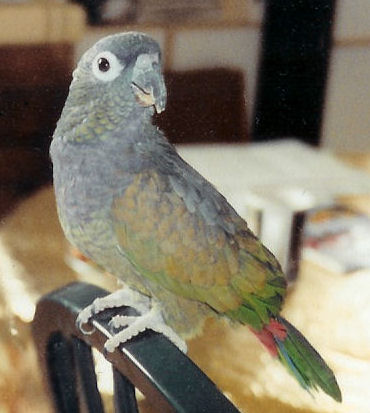Pionus - Maximilian
Scaly Headed Parrot, Scaly Face Pionus Scientific Name: Pionus maximiliani maximiliani
Thu, 9th January, 2025 - 2:32 am GMT
Sponsor Ads:

Alternative Name
Scaly Headed Parrot, Scaly Face Pionus Scientific Name: Pionus maximiliani maximilianiBasic Info
The Maximilian Pionus is a medium sized parrot, measuring 11.5 to 12 inches (29 to 30 centimeters) at maturity. They are the larges Pionus. Like other Pionus species, males and females cannot be distinguished visually. DNA or surgical sexing is required to differentiate males from females. Of all the Pionus species the Maximilian is the least colorful and some describe them as looking "unkempt" because it is not unusual for their down feathers to peak out from their plumage. They have a dark, muted olive green plumage. In direct sunlight, however, their plumage appears iridescent. Like other Pionus species the underside of their tails are red. They have violet blue bands on their necks and throats and nearly black lores. The feathers on their heads are outlined in dark grey and this gives the appearance of scales, which explains their unusual name. They have a dark brown iris and grey feet. Immatures can be distinguished from adults by the presence of red on their foreheads.
Health
The Maximilian Pionus does not have any special health concerns, other than a propensity to become overweight in captivity. This can be avoided, if they are kept stimulated with interesting toys and activities. They should also be fed a balanced, well rounded diet, and fatty seeds such as sunflower and safflower should only be fed as a treat. They should also be given plenty of fresh fruits and vegetables. Sadly the Maximilian Pionus usually only reaches half of its potential lifespan in captivity. This is largely due to improper diet and care. The average Maximilian Pionus lives 20 years, though they can reach 40 years with proper care. Breeding The Maximilian Pionus has been bred regularly in captivity. Aviculturists suggest breeding after they reach 3 years of age. After breeding, females will lay an average of 4 eggs that take 26 days to incubate. They may have 2 to 3 clutches in one season.Habitat
They are most common in open woodlands and light forest.Behavior
The Maximilian Pionus is also known as either the Scaly Face Pionus or the Scaly Head Parrot. The Maximilian Pionus is known for its good natured behavior and makes a good pet. They are not as high strung as some parrots, but they may also become overly sedate and this can lead to obesity, if they are not kept active. They are not aggressive and are known to do quite well in communal aviaries with other species. They should have plenty of toys and room to move about their cages. Unlike Amazon Parrots, the Maximilian Pionus is known for being quiet. They are, however, quite capable of being loud and this should be considered if looking for a suitable pet for an apartment. The Maximilian Pionus is an intelligent parrot, and like the Blue Headed Pionus, some have been reported to talk. They are not as good at talking as the African Grey, but many can develop a small vocabulary. There are four subspecies of Maximilian Pionus. The nominant form described in this article is described by the scientific name Pionus maximiliani maximiliani. The others are Ribeiro's Scaly-headed Parrot (P. m. melanoblepharus), the Siy Parrot (P. m. siy), and the Tucumán Parrot (P. m. lacerus). The last three subspecies are not as common in captivity as the nominant form.Origin
South AmericaHistory
The Maximilian Pionus is native to South America and is seen in parts of Brazil, Argentina, Bolivia, and Paraguay. In the wild the Maximilian Pionus is found in varying sized groups. Some may be as small as pairs, while others may travel in large flocks of up to 50 individuals. They are generally quiet in the wild when feeding.Common Foods
They will generally feed on nuts, wild figs, seeds, and berries.Sponsor Ads:
We have guided missiles, and misguided men" -- Martin Luther King
Pionus - Maximilian
Coded by: BGID® | ALL RIGHTS RESERVED Copyright © 2000-2025
Disclaimer | Privacy | Report Errors / Contact | Credits








 The Best Text Adventure You Will Ever Play! The official site:
The Best Text Adventure You Will Ever Play! The official site:  Homosexual behavior stems from the mind or genetics?
Homosexual behavior stems from the mind or genetics?  Why haven't we as a collective earth met with aliens yet?
Why haven't we as a collective earth met with aliens yet?  World EcoSystem - Biodiversity Changes - Who is on board and who isn
World EcoSystem - Biodiversity Changes - Who is on board and who isn  Mouthwash - Mouthrinse - Mouth Sores - Healing Infections - Gingivitis
Mouthwash - Mouthrinse - Mouth Sores - Healing Infections - Gingivitis  Treatment for Depression
Treatment for Depression  Ultra radical and violent Islamist group that even rivals Al Qaeda
Ultra radical and violent Islamist group that even rivals Al Qaeda  An idea to have teachers who want to carry guns to school undergo some level of police training will be left up to local school districts and police departments.
An idea to have teachers who want to carry guns to school undergo some level of police training will be left up to local school districts and police departments.